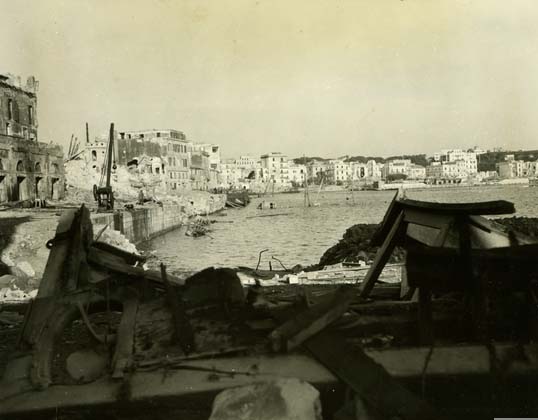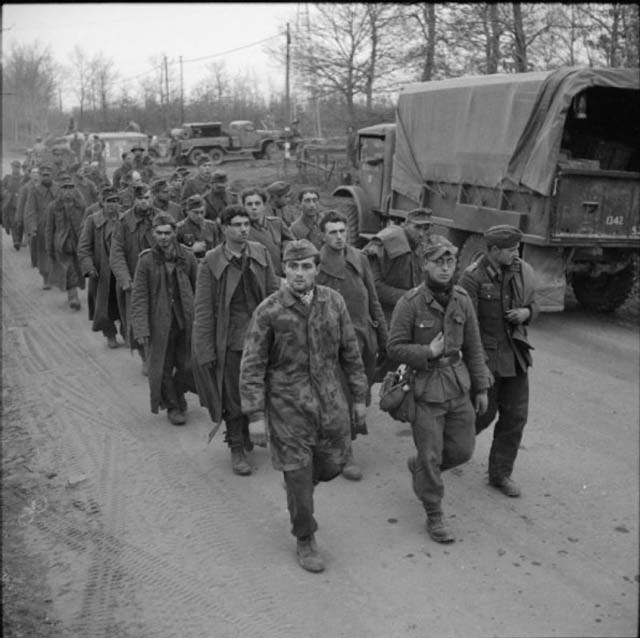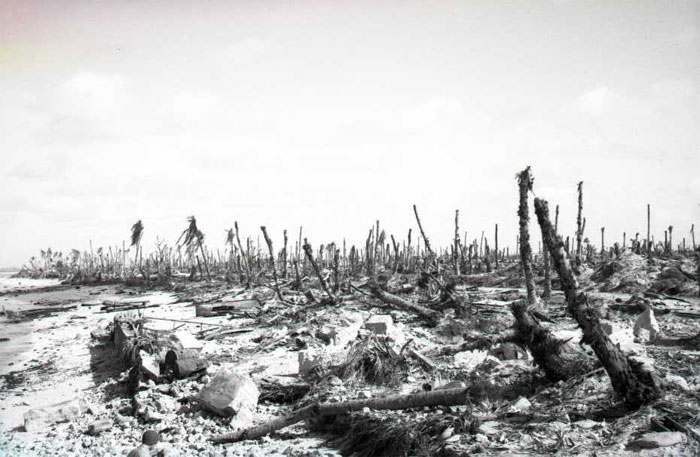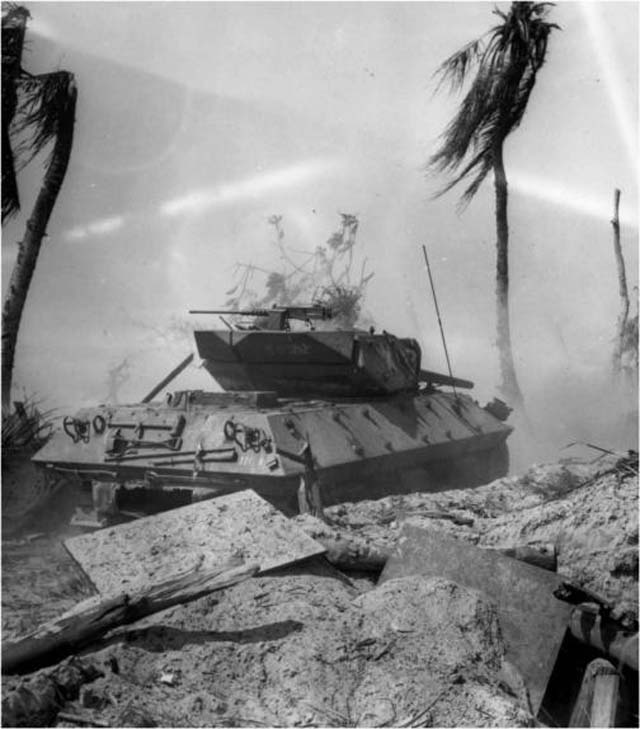Air Operations, Bismarcks
- AirSols SBDs, escorted by many AirSols fighters, attack the Tobera airfield at Rabaul immediately following which 17 XIII Bomber Command B-24s, escorted by many fighters attack, the same target.
- VMF-211, VMF-212, and VMF-217 F4Us and a VF-38 F6F down 7 A6M Zeros in the Rabaul area between 1005 and 1055 hours.
Air Operations, East Indies
380th Heavy Bomb Group B-24s attack shipping off Cerman.
[Air Operations, Europe
USAAFNETHERLANDS:
- 75 4th, 78th, and 355th Fighter Group P-47 dive-bombrs are dispatched, along with an escort composed of 47 P-38s and 87 P-47s, to attack the Gilze-Rijen Airdrome. 70 of the P-47 dive-bombers attack the briefed primary with 1 500-pound bomb apiece. The P-47 escort pilots down 5 Bf-109s near the Gilze-Rijen Airdrome between 1445 and 1500 hours. 55th Fighter Group P-38 pilots down 6 Bf-109s and 2 FW-190s between 1520 and 1630 hours, while conducting a sweep over the Eindhoven-Venlo-Arnhem area.
FRANCE:
- 74 8th Air Force B-24s, escorted by 114 P-47s, make an unopposed attack on V-weapons sites at St.-Pol/Siracourt.
ITALY:
- XII Air Support Command A-20s attack a town and a road junction.
- XII Air Support Command A-36s and P-40s attack several towns and a road junction east of the Anzio beachhead.
- XII Air Support Command P-47 fighter-bombers attack a town.
AUSTRIA:
- 74 15th Air Force B-17s attack the Klagenfurt Airdrome, just north of the Austro-Italian border. Of 67 aircraft counted on the ground at the time of the attack, 11 are claimed as destroyed and 7 are claimed as damaged.
- 41 15th Air Force B-24s attack the Aviano Airdrome.
- 70 15th Air Force B-17s attack the Udine Airdrome.
- 325th Fighter Group P-47 escort pilots down 2 Bf-109s and 3 SM-82s near Udine between 1255 and 1315 hours.
Air Operations, Marshalls
- Operation FLINTLOCK, the invasion of the Marshall Islands, opens in northern Kwajalein Atoll with the seizure by US Marines of 5 preliminary island objectives. Highly efficient close support is provided by naval gunfire and aircraft from 3 escort carriers (Task Unit 53.1.6) and 2 fleet carriers and 1 light carrier (Task Group 58.2). Little opposition is encountered on the ground at this time, but continuous on-call air support is available throughout the day.
- ;With somewhat less direct support, owing to the much larger pre-landng bombardment of Kwajalein Island, US. Army troops occupy 4 islands and islets in southern Kwajalein Atoll against weak to moderate opposition. The main southern landing of the day, on Enubuj Island, is preceded by intense naval gunfire support and rocket, bombing, and strafing attacks by 51 fighters and bombers from Task Unit 52.9.1 (Southern Attack Force Carrier Support Unit) escort carriers.
- By this date, ongoing strikes by Task Group 58.2 carrier warplanes have crippled or destroyed every one of the 83 Japanese Navy aircraft thought to be based at the Roi airfield on Kwajalein on January 29, at the start of the pre-landing carrier offensive. By day’s end, Task Group 58.1 aircraft have joined Task Group 58.2 aircraft in pummeling ground defenses on Roi and adjacent Namur, the primary objectives of the bulk of the US 4th Marine Division. Despite the heavy air and naval bombardment, the Roi airfield on Kwajalein is spared to the extent possible as it is to be rehabilitated as quickly as possible for use by regional land-based aviation units.
- 19 531st Fighter-Bomber Squadron A-24s attack the airfield on Mille, which is patrolled and harassed by VII Fighter Command P-39s and P-40s for the entire day. 45th Fighter Squadron P-40s strafe targets in the Jaluit Atoll and Task Group 58.3 carrier aircraft continue to pound targets in the Eniwetok Atoll.
- Before a scheduled amphibious assault by US Army troops can get underway, the Majuro Atoll is secured in its entirety by US Marine scouts—without a fight. Majuro is the first of Japanese pre-war holdings to fall into Allied hands. It will be turned into a major advance US Navy fleet anchorage.
- Throughout the night, 8 VII Bomber Command B-24s mount individual attacks against the Wotje Atoll.
Air Operations, New Guinea
V Bomber Command A-20s attack Uligan Harbor and V Fighter Command P-39s strafe Bogadjim, Bostrem Bay, and the landing ground at Alexishafen.
[Atlantic
German MTBs attack Convoy CW-243. 2 ships are sunk.
[Australia, Home Front
A commission is established to investigate Japanese war crimes.
[Battle of the Atlantic
U-592 is operating in the area of two convoys, SL-47 and MKS-38, when picked up in an asdic contack. She is attacked by the British sloop Wild Goose followed by an additional attack by the British sloop Starling. It is after the second attack a large explosion is heard and all kinds of debris rose to the surface.
| Class | Type VIIC |
| CO | Oberleutnant zur See Heinz Jaschke |
| Location | Atlantic, W of Cape Clear |
| Cause | Depth charge |
| Casualties | 49 |
| Survivors | None |
Eastern Front
Soviet troops reach the outskirts of Kingisepp in their drive west from Leningrad.
NORTHERN SECTORThe fighting in the Leningrad sector has carried the 2nd Shock Army and 42nd Army to the Luga River north and south of Kingisepp.
SOUTHERN SECTORHeavy fighting rages east of Krivoi Rog and around Nikopol as the German 6th Army is crushed by the 3rd and 4th Ukrainian Fronts.
In the Crimea the Germans have erected strong defensive positions. The XLIX Mountain Corps deploys 1 infantry division on the Perekop Isthmus and 1 infantry and 2 Rumanian divisions on the Zivash coast facing the 51st Army. The V Corps is near Kerch with 2 infantry and 1 Rumanian cavalry division facing the Independent Coastal Army. In the Jaila Mountains is the I Rumanian Mountain Corps, fighting Crimean partisans, while in operational reserve is another infantry division, Mountain Regiment Krym and the 9th Flak Division. The 17th Army has a total strength of 235,000 men.
THE OSTHEER1 panzer division, 1 infantry and 2 Luftwaffe field divisions have been struck off the German order of battle during January but in return 1 SS motorized division, 1 infantry and 1 ski division are commited, bringing the total German commitment to 23 panzer, 10 panzer grenadier and 139 infantry divisions. The Luftwaffe has 1,800 aircraft against 8,500 Soviet planes.
[English Channel
The British minesweeping trawler Pine is sunk by a German s-boat of the 5th Motor Torpedo Boat Flotilla southeast of Beachy Head with the loss of 10 of her crew.
[Italy
In the US 5th Army's VI Corps area, superior enemy forces bar the 3rd Division from Cisterna. The British 1st Division and the 1st Armored Division are stubbornly opposed from the Campoleone area. An attack up the Albano road is halted by VI Corps order at night. In the British X Corps area, the 138th Brigade of the 46th Division reaches Monte Purgatorio. In the II Corps area, the 168th Infantry, 34th Division, seizes Cairo village and repels further counterattacks. The 133rd begins clearing the barracks area north of Cassino. In the FEC area, the 2nd Battalion of the 142n Infantry, US 36th Division, overruns Manna Farm. The French recapture Abate Hill.
[Marshalls
The landing operations against Kwajalein Atoll begin Operation FLINTLOCK. Adm Nimitz has assembled the biggest force so far employed in a single operation in the Pacific
40,000 men of the Marines and army, against Rear-Adm Monzo Akiyama's forces of about 8,000. The archipelago, made up of 36 atolls comprising at least 2,000 islands and islets, is about 620 miles long and cannot be 'skipped' in any attack from the South Pacific toward Japan. The Japanese, well aware of this, have strengthened their defenses, especially those of the major atolls, on which thay have built a number of airfields. For some time, however, the 750 aircraft of Task Force 58 and hundreds more from bases in the Gilbert and Ellice Islands have been hammering the military installations and sea traffic. Adm Spruance is in overall command with Gen Holland Smith in charge of the various landing forces, the souther attack force under Rear-Adm Richmond K. Turner, the northern attack force under Rear-Adm Richard L. Conolly, the Majuro attack group and the reserve force under Rear-Adm Hill.
During the night the Majuro attack force lands units of the 106th Regt of the 27th Inf Div on Majuro atoll. By the evening the atoll is firmly in their hands. At the same time a large number of US torpedo-boats attack the twin islands of Roi and Namur, the first of which consists almost entirely of the airfield. Starting at first light, Marines and army troops land on undefended islets a short way from Roi-Namur and Kwajalein, the southernmost island in the atoll of that name, and locate guns there so that they direct fire on the bigger islands, which are then subjected to an intense barrage of fire from B-24 Liberator bombers, carrier based aircraft and the battleships Tennessee (BB-43), Colorado (BB-45) and Maryland (BB-46). Never before has a landing been preceded by such a heavy barrage. The islands of Roi and Namur disappear under a cloud of smoke and dust, and many of the defenders are killed.
At 12:15p.m. the Marines of the 23rd and 24th Regts launch their assault. They advance fairly quickly on Roi, but on Namur they are held up by some Japanese pillboxes which have escaped destruction. The explosion of a big dump of torpedoes and of 2 ammunition depots blown up by the Japanese causes numerous casualties among the attacking troops. During that night the Japanese put in furious counter-attacks, which are driven off with the support of tanks.
Two US naval vessels are damaged in the day's operations: the heavy cruiser Louisville (CA-28) by naval gunfire; and the destroyer Colahan (DD-658) by grounding.
Majuro is quickly made ready to become a major American base. It becomes operational on Febrary 2. The main carrier forces of TF 58 continue their attacks on these objectives and against Eniwetok and Maleolap.
[Occupied France
The Resistance blows up the Ratier aircraft propeller works at Figéac.
[Pacific
- The Japanese submarine I-171 is sunk by the US destroyers Guest (DD-472) and Hudson (DD-475) in the Bismarck Archipelago area.
- The Japanese minelayer Nasami is sunk by the US submarine Trigger (SS-237) in the Central Pacific area.
- The Japanese auxiliary submarine chaser No. 33 is sunk by aircraft in the Central Pacific area.
- The US submarine Tullibee (SS-284) sinks the Japanese auxiliary netlayer Hiro Maru (549t) north-northwest of Saipan.
Southwest Pacific
Within the SWPA, Gen MacArthur has five army division, the 1st Cavalry, the 6th Infantry, the 24th Infantry, the 32nd Infantry, and the 41st Infantry. He also has three regimental combat teams, the 112th Cavalry, the 158th Infantry Regiment, and the 503rd Parachute Infantry Regiment. He can expect the arrival of three more divisions, the 31st Infantry, the 33rd Infantry, and the 43rd Infantry. The 5th Air Force number about 1,000 aircraft and Vice-Adm Thomas c. Kinkaid, commander of the 7th Fleet, has a greatly expanded amphibious and sea transport capability. In the month of January, 308 B-24, 107 B-25, and 9 B-26 sorties have been carried out against Alexishafen and Madang, employing a total of 1,100 tons of bombs against the Japanese holding out against the Australians.
[Images from January 31, 1944
|
|
|
|
|
|





